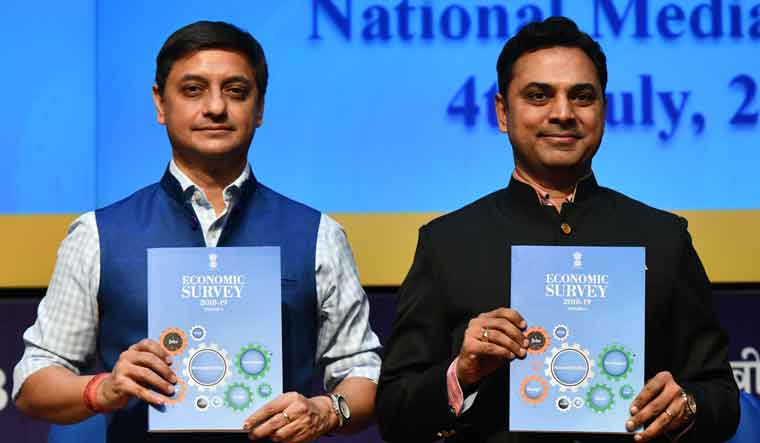If Prime Minister Narendra Modi wants to touch the bright blue sky in terms of transforming India into a $5-trillion economy by 2024-25, the blue Economic Survey 2018-19 tabled in Parliament on Wednesday will help him. It comes with the blueprint and tactical tools to shift gears to grow at 8 per cent GDP continuously and actually achieve that goal. Apparently, what we really need to get there are three things: investments, people's behaviour, and clearing the legal jam.
Chief Economic Adviser K.V. Subramanian, who prepared his first Economic Survey, said the colour, to him, represented unfettered thinking as he looks to put the country in a “virtuous cycle”. “Investment, whether from FDI or domestic savings, is the key driver and exports is the goal,” he said during his presentation.
If India's current domestic savings of 29.4 per cent of GDP goes up by even 5 per cent on a constant basis, investment as a percentage of GDP will increase, leading to manufacturing, jobs and exports. His team had seen the evidence of this “virtuous cycle” in the China growth story, and indeed, it was investments that led to high growth rate in economies in East Asia, too.
As investments grow, and GDP grows, consumption will decline, he said, flagging what according to Principal Economic Adviser Sanjiv Sanyal was what they wanted—not domestic consumption but exports.
Subramanian and his team have relied on “behavioural economics for path-breaking changes”, making a significant departure from the traditional economics of equilibrium of economics of silos. Classic economics, he elaborated, equates people with robots, while this was about leveraging the behavioural economics of “nudge”, for example the ideas of “Swachh Bharat” or “Beti Bachao Beti Padhao” schemes. The former had resulted in improved health outcomes, among other things, and the latter had brought about a dramatic drop in the sex ratio. If, upon government's asking, many gave up subsidy on LPG cylinders, behavioural economics suggests people would start thinking if they really need subsidies?
But that kind of behavioural idealism apart, the Economic Survey emphatically and graphically shows that small manufacturing units that do not grow, do not contribute to jobs or value addition. Specifically, 84.3 per cent of small firms contribute 22.9 per cent to employment and 11.6 per cent to growth. In contrast, 11.5 per cent big firms contribute 77.1 per cent to employment and 88.5 per cent to value addition. Coming down on what it called “nourishing dwarfs”, the survey makes a strong case for doing away with incentives to the infants, in order to make them grow. Many he admitted, remained small because of the benefits government policies give the MSMEs.
While a strong injection of investment was what the Economic Survey saw as the panacea for much of the ills of the MSMEs, its prescription included incentivising infant firms rather than small firms, having a sunset clause for incentives with grandfathering, focus on infant firms in employment intensive sectors and the service sector.
also read
- OPINION: Why Chinese economy is facing a massive slowdown
- India forex reserves plummet to 7-month low as rupee keeps falling: RBI data
- 2025 could be the year of consolidation; important to have rational expectations: Nippon MF’s Sailesh Bhan
- Govt data for steel plants: Gujarat is national leader, but these south states suffer from lack of enough steel units
The Economic Survey has a favourable take on data, saying it is a public good, whose marginal cost had dropped a lot and marginal benefits increased very significantly. The CEA preferred not to comment on the GDP figure controversy following his predecessor Dr Arvind Subramanian's research finding that showed the GDP about 2.5 per cent lower than what the government believes it is. "A lot has already been written about it", he said.
And as the country celebrates the 150th birth anniversary of Mahatma Gandhi, Subramanian said they had been inspired by the talisman he gave with reference to the poorest man. And so it is that the survey in two volumes includes, for the first time, an abstract and a “chapter at a glance”, apart from a two-minute video in Hindi and English—to be intelligible to all.
But the most important step towards making India a $5-trillion economy by 2024-25, according to the Economic Survey, is clearing the legal jam. And the survey says it is neither difficult nor costly. In the district and subordinate courts, an additional 2,279 judges will result in 100 per cent clearance, zero per cent backlog and 25 per cent increase in productivity in five years.
In the high courts, 93 more judges will make for a cent per cent clearance, and 41 per cent increase in productivity in five years. And one additional judge is what it will take in the Supreme Court to effect a zero backlog and an 18 per cent increase in productivity. “This is the best investment that India can make to go towards the $5-trillion economy”.



